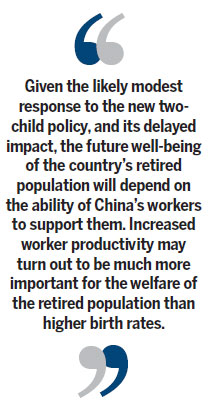
Easing of one-child policy may do little to solve the demographic problems that country faces
Since the 1980s, the increase in China's working population has been an important factor supporting the country's economic growth. But this trend is now in reverse.
In the decade from 2011, China is projected to add about 73 million retired people to its population, but the size of the Chinese workforce will remain roughly static. From 2020, the aging trend will accelerate, with the workforce set to shrink by about 60 million, while the retired population will increase by more than 100 million.
In 1975, there were six Chinese children for every elder. According to a projection made in a 2009 study done by the Center for Strategic and International Studies in Washington, by 2035 there will be two Chinese elders for every child.
In a few years, there will be fewer working people in each family to support under-age children and retired relatives. Increased life expectancy means more Chinese workers will find themselves retiring before their parents have died, making two generations of retired in many families to be supported by one couple, who will have their own child or children to support.
In November, the Chinese government took a step toward addressing this looming demographic problem. The decision at the Party's plenum to relax the 1979 regulation that restricted most of urban Han Chinese families to having only one child means that couples, if one of them is an only child, can now choose to have two children instead of just one.
The step is a welcome expression of the government's recognition of peoples' needs and concerns. But demographics is a science focused on the long term. Such is the long-term nature of population evolution that even if every young Chinese couple were to take advantage of the new regulation, the demographic and social impacts would only start to be felt decades from now.

Meanwhile, in line with the demographic trend in richer developed regions, the newly prosperous Chinese middle class is having fewer children. In rich, developed Hong Kong, the fertility rate is just over 1 child per woman, against an average rate of 1.8 throughout the mainland, and 2.52 globally.
Will young Chinese women from the growing middle class support the new government policy by choosing to have two children? When, after the new regulation was announced in November, I asked some of the young mothers among the support staff at Peking University, they all told me that they would not be having a second child, as they could not afford it, and it was too much trouble.
A 2006 survey carried out by China's National Population and Family Planning Commission reported that 57 percent of Chinese women consider two children to be ideal, while 35 percent prefer to have only one. The impact of the relaxation of the one-child policy on China's demographics may be modest.
In that case, how will China's growing retired population grow old enjoyably and gracefully? The question has an important bearing on the government's efforts to switch the main driver of China's economic growth toward private spending and away from government-led investment.
An important explanation for China's high savings rate can be found in the restructuring of the state-owned sector in the 1990s, when state-owned enterprises shed their cradle-to-grave responsibility for their employees, at the same time making more than 50 million of them redundant. In the absence of old-age provision by the state, Chinese families took on the responsibility for this army of aging workers.
With this event still fresh in the minds of many, most Chinese workers today continue to save a high proportion of their incomes, for fear of becoming destitute as they grow old. Given a still-modest funding level of state retirement schemes, the capacity of the Chinese state to support a growing retired population will depend largely on monthly contributions from workers' pay packets. Given the likely modest response to the new two-child policy, and its delayed impact, the future well-being of the country's retired population will depend on the ability of China's workers to support them. Increased worker productivity may turn out to be much more important for the welfare of the retired population than higher birth rates.
In this context, the November plenum's decision to retain state control over "strategic" industries has highlighted the debate over what constitutes a strategic industry. Is auto production, where foreign companies are forbidden from taking majority control, a strategic industry? What about banking, where increased competition and new capital from foreign banks are badly needed in China? The lifestyles of China's elders in 2030 and beyond will depend as much on the correct determination of these issues as on whether Chinese mothers decide to have an extra child.
The author is a visiting professor at Guanghua School of Management, Peking University.
(China Daily Africa Weekly 02/14/2014 page9)








